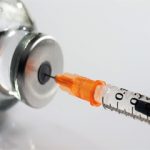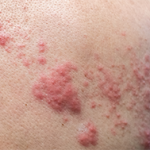
The Janus kinase 1 protein.
StudioMolekuul / shutterstock.com
SNOWMASS VILLAGE, COLO.—Janus kinase inhibitors—or Jakinibs—are a relatively new class of disease-modifying anti-rheumatic drugs (DMARDs) that perform well and have a safety profile comparable to biologics. This group of drugs was the subject of The New Frontier: Comparative Safety of JAK Inhibitors, a presentation given at the ACR Winter Symposium by Kevin L. Winthrop, MD, MPH, professor, School of Public Health, Division of Infectious Diseases, Oregon Health & Science University, Portland.*
Dr. Winthrop has been working to understand the safety of Jakinibs “since the early days” of their development, he said, and shared current information about Jakinibs, their safety profile and potential risks, and key considerations for their use.
Current Market
In the U.S. today, three JAK inhibitors are approved for use in rheumatology patients: tofacitinib, baricitinib and upadacitinib. Another Jakinib, peficitinib, is approved for rheumatoid arthritis (RA) treatment in Japan, and ruxolitinib is approved by the U.S. Food & Drug Administration (FDA) to treat myelofibrosis. Several other drugs are in various phases of development and testing, so it’s expected that more will enter the market soon.
All of these medications are pretty similar, although they have slightly different targets, Dr. Winthrop said. Specifically, tofacitinib targets JAK1 and JAK3, baricitinib targets JAK1 and JAK2, and upadacitinib targets JAK1. But all Jakinibs can have off-target effects and become less selective at higher doses.
Safety & Risks
The safety profile of the various Jakinibs is similar to that of biologic drugs, Dr. Winthrop said, but tofacitinib has been studied the most because it has been approved for use the longest. He shared results from numerous studies:
- A 2016 study of more than 5,600 patients, published in Annals of the Rheumatic Diseases, showed no increased risk of malignancy with tofacitinib;1
- Another study, published in 2014 in Arthritis & Rheumatology, showed the overall risk of infection (including serious infection) and mortality rates in rheumatoid arthritis (RA) patients treated with tofacitinib were similar to those observed in RA patients treated with biologic agents;2 and
- In a 2015 study, published in Annals of the Rheumatic Diseases, Dr. Winthrop and colleagues noted an increased risk of opportunistic infections among patients with RA using tofacitinib, but infection occurrence overall was rare.3
The more pronounced differences between Jakinibs and biologics are the increased risk of viral infection (specifically herpes zoster) and perhaps some vascular events.
Dr. Winthrop and colleagues studied the correlation between tofacitinib treatment and herpes zoster, and published their results in a 2014 issue of Arthritis & Rheumatology.4 They concluded that RA patients being treated with tofacitinib had an increased incidence of herpes zoster infection compared with patients taking placebo, especially patients in Asia; however, complicated infections were rare in patients receiving treatment.
An increased risk of infection is to be expected, Dr. Winthrop said, because of the mechanism of action of Jakinibs. They are known to down-regulate interferon-gamma and diminish cell-mediated immunity and innate immune function, such as the number and activity of natural killer (NK) cells.
An increased risk of infection is to be expected, … because of the mechanism of action of JAK inhibitors. They are known to down-regulate interferon-gamma & diminish cell-mediated immunity & innate immune function.
The effect on vascular health is “an area of active investigation where there are some potential signals suggesting there are differences there, and maybe with Jakinibs the risk is elevated. But it’s not clear,” Dr. Winthrop said.
In a 2018 FDA submission from Eli Lilly, an elevated risk of venous thromboembolism (VTE) was reported for patients taking baricitinib.5 In conclusion, the submission indicated that VTE is an “important potential risk,” although investigations are ongoing to further clarify any correlation.
Similarly, the FDA issued a warning about an increased risk of pulmonary embolism (PE) in RA patients taking 10 mg of tofacitinib twice daily.6 This warning came as a result of a post-market safety trial required as a condition of drug approval.
Overall, the research shows Jakinibs are “very efficacious and fairly safe,” Dr. Winthrop said. “They have safety concerns for the most part similar to other DMARDs, and in some cases [these risks are] somewhat specific or different [from] other drugs being used. It’s an interesting place to be to understand those differences and create ways to prevent problems and mitigate safety concerns.”
Key Considerations
Because of the increased risk of herpes zoster infection with Jakinibs, it’s important that patients receive the shingles vaccine before starting treatment, Dr. Winthrop said. “Figuring out how best to prevent zoster is a huge goal,” he noted, adding that new studies are planned to help establish best practices.
Rheumatologists can encourage their patients to get involved in such studies to help answer pressing questions about Jakinibs and, ultimately, improve treatment options and success for all patients.
Another risk factor for infections is prednisone therapy. Added to Jakinibs, prednisone leads to a “marked increase in risk,” said Dr. Winthrop. Thus, minimizing or eliminating prednisone therapy in patients who are going to start Jakinibs is very important.
Although certain precautions should be taken and new research will elucidate more about this class of drugs as time goes on, Jakinibs are a good option for helping rheumatology patients get their disease under control.
In addition to keeping up with information added to drug labels, Dr. Winthrop said, rheumatologists can stay up to date on Jakinibs by reading journals or attending European League Against Rheumatism (EULAR) and ACR conferences to see the latest research, and by reviewing information from guideline makers, such as the ACR and the European Congress of Rheumatology, when they are published.
Kimberly Retzlaff is a freelance medical journalist based in Denver.
References
- Curtis JR, Lee EB, Kaplan IV, et al. Tofacitinib, an oral Janus kinase inhibitor: Analysis of malignancies across the rheumatoid arthritis clinical development programme. Ann Rheum Dis. 2016 May;75(5):831–841.
- Cohen S, Radominski SC, Gomez-Reino JJ, et al. Analysis of infections and all‐cause mortality in phase II, phase III, and long‐term extension studies of tofacitinib in patients with rheumatoid arthritis. Arthritis Rheumatol. 2014 Nov;66(11):2924–2937.
- Winthrop KL, Park S-H, Gul A, et al. Tuberculosis and other opportunistic infections in tofacitinib-treated patients with rheumatoid arthritis. Ann Rheum Dis. 2016 Jun;75(6):1133–1138.
- Winthrop KL, Yamanaka H, Valdez H, et al. Herpes zoster and tofacitinib therapy in patients with rheumatoid arthritis. Arthritis Rheumatol. 2014 Oct;66(10):2675–2684.
- Lilly. Baricitinib (LY3009104): Rheumatoid Arthritis (briefing document). NDA 207924. FDA Advisory Committee Meeting. 2018 Apr 23.
- Brown T. FDA warns of risk for PE, death with higher dose tofacitinib (Xeljanz) for RA. Medscape. 2019 Feb 25.
* Dr. Winthrop has received research funding from Pfizer and BMS; performed consultant work for Amgen, AbbVie, Pfizer, UCB, Genentech, BMS and Lilly; and serves on the data safety monitoring boards for RCTs conducted by UCB, Roche, Astellas, Lilly, Janssen and Galapagos.


